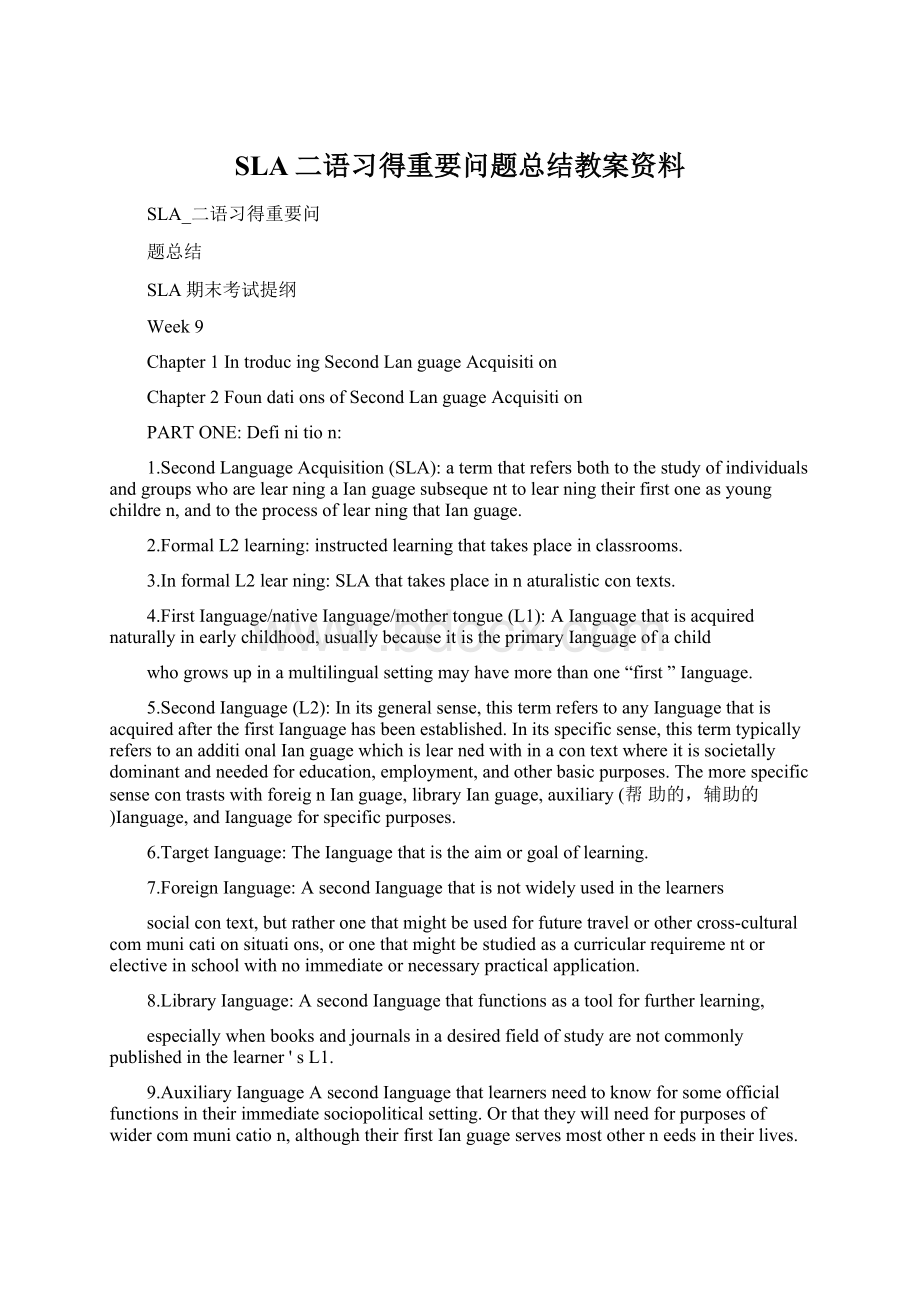SLA二语习得重要问题总结教案资料Word下载.docx
《SLA二语习得重要问题总结教案资料Word下载.docx》由会员分享,可在线阅读,更多相关《SLA二语习得重要问题总结教案资料Word下载.docx(36页珍藏版)》请在冰豆网上搜索。

instructedlearningthattakesplaceinclassrooms.
3.InformalL2learning:
SLAthattakesplaceinnaturalisticcontexts.
4.FirstIanguage/nativeIanguage/mothertongue(L1):
AIanguagethatisacquirednaturallyinearlychildhood,usuallybecauseitistheprimaryIanguageofachild
whogrowsupinamultilingualsettingmayhavemorethanone“first”Ianguage.
5.SecondIanguage(L2):
Initsgeneralsense,thistermreferstoanyIanguagethatisacquiredafterthefirstIanguagehasbeenestablished.Initsspecificsense,thistermtypicallyreferstoanadditionalIanguagewhichislearnedwithinacontextwhereitissocietallydominantandneededforeducation,employment,andotherbasicpurposes.ThemorespecificsensecontrastswithforeignIanguage,libraryIanguage,auxiliary(帮助的,辅助的)Ianguage,andIanguageforspecificpurposes.
6.TargetIanguage:
TheIanguagethatistheaimorgoaloflearning.
7.ForeignIanguage:
AsecondIanguagethatisnotwidelyusedinthelearners
socialcontext,butratheronethatmightbeusedforfuturetravelorothercross-culturalcommunicationsituations,oronethatmightbestudiedasacurricularrequirementorelectiveinschoolwithnoimmediateornecessarypracticalapplication.
8.LibraryIanguage:
AsecondIanguagethatfunctionsasatoolforfurtherlearning,
especiallywhenbooksandjournalsinadesiredfieldofstudyarenotcommonlypublishedinthelearner'
sL1.
9.AuxiliaryIanguageAsecondIanguagethatlearnersneedtoknowforsomeofficialfunctionsintheirimmediatesociopoliticalsetting.Orthattheywillneedforpurposesofwidercommunication,althoughtheirfirstIanguageservesmostotherneedsintheirlives.
10.Linguisticcompetenee:
Theunderlyingknowledgethatspeakers/hearershaveofaIanguage.Chomskydistinguishesthisfromlinguisticperformanee.
11.Linguisticperformanee:
TheuseofIanguageknowledgeinactualproduction.
12.Communicativecompetence:
Abasictenet(原则、信条、教条)ofsociolinguisticsdefinedas“whataspeakerneedstoknowtocommunicateappropriatelywithinaparticularlanguagecommunitySaville”-Tr(oike2003)
13.Pragmaticcompetence:
Knowledgethatpeoplemusthaveinordertointerpretandconveymeaningwithincommunicativesituations.
14.Multilingualism:
Theabilitytousemorethanonelanguage.
15.Monolingualism:
Theabilitytouseonlyonelanguage.
16.Simultaneousmultilingualism:
Abilitytousemorethanonelanguagethatwereacquiredduringearlychildhood.
17.Sequentialmultilingualism:
AbilitytouseoneormorelanguagesthatwerelearnedafterL1hadalreadybeenestablished.
18.Innatecapacity:
Anaturalability,usuallyreferringtochildren'
snaturalability
acquirelanguage.
19.Childgrammar:
Grammarofchildrenatdifferentmaturationallevelsthatissystematicintermsofproductionandcomprehension.
20.Initialstate:
Thestartingpointforlanguageacquisition;
itisthoughttoincludetheunderlyingknowledgeaboutlanguagestructuresandprinciplesthatareinlearnersattheverystartofL1orL2acquisition.
21.Intermediatestate:
Itincludesthematurationalchangeswhichtakeplacein“childgrammar”,andtheL2developmentalsequencewhichisknownaslearnerlanguage.
22.Finalstate:
TheoutcomeofL1andL2leaning,alsoknownasthestablestateofadultgrammar.
23.Positivetransfer:
AppropriateincorporationofanL1structureorruleinL2structure.
24.Negativetransfer:
InappropriateinfluenceofanL1structureorruleonL2use.Alsocalledinterference.
25.Poverty-of-the-stimulus:
TheargumentthatbecauselanguageinputtochildrenisimpoverishedandtheystillacquireL1,theremustbeaninnatecapacityforL1acquisition.
26.Structuralism:
Thedominantlinguisticmodelofthe1950s,whichemphasizedthedescriptionofdifferentlevelsofproductioninspeech.
27.Phonology:
Thesoundsystemsofdifferentlanguagesandthestudyofsuchsystemsgenerally.
28.Syntax:
Thelinguisticsystemofgrammaticalrelationshipsofwordswithinsentences,suchasorderingandagreement.
29.Semantics:
Thelinguisticstudyofmeaning.
30.Lexicon:
Thecomponentoflanguagethatisconcernedwithwordsandtheirmeanings.
31.Behaviorism:
Themostinfluentialcognitiveframeworkappliedtolanguagelearninginthe1950s.Itclaimsthatlearningistheresultofhabitformation.
32.Audiolingualmethod:
Anapproachtolanguageteachingthatemphasizesrepetitionandhabitformation.Thisapproachwaswidelypracticedinmuchoftheworlduntilatleastthe1980s.
33.Transformational-GenerativeGrammar:
Thefirstlinguisticframeworkwithaninternalfocus,whichrevolutionizedlinguistictheoryandhadprofoundeffectonboththestudyoffirstandsecondlanguages.Chomskyarguedeffectivelythatthebehavioristtheoryoflanguageacquisitioniswrongbecauseitcannotexplainthecreativeaspectsoflinguisticability.Instead,humansmusthavesomeinnatecapacityforlanguage.
34.PrinciplesandParameters(model):
TheinternallyfocusedlinguisticframeworkthatfollowedChomskyT'
rasnsformational-GenerativeGrammar.ItrevisedspecificationsofwhatconstitutesinnatecapacitytoincludemoreabstractnotionsofgeneralprinciplesandconstraintscommontohumanlanguageaspartofaUniversalGrammar.
35.Minimalistprogram:
TheinternallyfocusedlinguisticframeworkthatfollowedChomsky'
PsrinciplesandParametersmodel.Thisframeworkaddsdistinctionsbetweenlexicalandfunctionalcategorydevelopment,aswellasmoreemphasisontheacquisitionoffeaturespecificationasapartoflexicalknowledge.
36.Functionalism:
AlinguisticframeworkwithanexternalfocusthatdatesbacktotheearlytwentiethcenturyandhasitsrootsinthePragueSchool布拉格学派)ofEasternEurope.
Itemphasizestheinformationcontentofutterancesandconsiderslanguageprimarilyasasystemofcommunication.FunctionalistapproacheshavelargelydominatedEuropeanstudyofSLAandarewidelyfollowedelsewhereintheworld.
37.Neurolinguistics:
Thestudyofthelocationandrepresentationoflanguageinthebrain,ofinteresttobiologistsandpsychologistssincethenineteenthcenturyandoneofthefirstfieldstoinfluencecognitiveperspectivesonSLAwhensystematicstudybeganin1960s.
38.Criticalperiod:
ThelimitednumberofyearsduringwhichnormalL1acquisitionispossible.
39.CriticalPeriodHypothesis:
TheclaimthatchildrenhaveonlyalimitednumberofyearsduringwhichtheycanacquiretheirL1flawlessly;
iftheysufferedbraindamagetothelanguageareas,brainplasticityinchildhoodwouldallowotherareasofthebraintotakeoverthelanguagefunctionsofthedamagedareas,butbeyondacertainage,normallanguagedevelopmentwouldnotbepossible.ThisconceptiscommonlyextendedtoSLAaswell,intheclaimthatonlychildrenarelikelytoachievenativeornear-nativeproficiencyinL2.
40.Informationprocessing(IP):
AcognitiveframeworkwhichassumesthatSLA(likelearningofothercomplexdomains)proceedsfromcontrolledtoautomaticprocessingandinvolvesprogressivereorganizationofknowledge.
41.Connectionism:
Acognitiveframeworkforexplaininglearningprocesses,beginninginthe1980sandbecomingincreasinglyinfluential.ItassumesthatSLAresultsfromincreasingstrengthofassociationsbetweenstimuliandresponses.
42.Variationtheory:
AmicrosocialframeworkappliedtoSLAthatexploressystematicdifferencesinlearnerproductionwhichdependoncontextsofuse.
43.Accommodationtheory:
AframeworkforstudyofSLAthatisbasedonthenotionthatspeakersusuallyunconsciouslychangetheirpronunciationandeventhegrammaticalcomplexityofsentencestheyusetosoundmorelikewhomevertheyaretalkingto.
44.Socioculturaltheory(SCT):
AnapproachestablishedbyVygotskywhichclaimsthatinteractionnotonlyfacilitatesIanguagelearningbutisacausativeforceinacquisition.Further,alloflearningisseenasessentiallyasocialprocesswhichisgroundedinsocioculturalsettings.
45.Ethnography(人种论、民族志)ofcommunication:
AframeworkforanalysisofIanguageanditsfunctionsthatwasestablishedbyHymes(1966).ItrelatesIanguageusetobroadersocialandculturalcontexts,andappliesethnographicmethodsofdatacollectionandinterpretationtostudyofIanguageacquisitionanduse.
46.
Acculturation(文化适应):
LearningthecultureoftheL2communityandadaptingtothosevaluesandbehaviorpatterns.
asidentityandstatuswhichdeterminesocialandpsychologicaldistaneebetweenlearnerandtargetIanguagepopulations.HeclaimstheseinflueneeoutcomesofSLA.
48.Socialpsychology:
Asocietalapproachinresearchandtheorythatallowsexplorationofissuessuchashowidentity,status,andvaluesinfluenceL2outcomesandwhy.Ithasdisciplinarytiestobothpsychologicalandsocialperspectives.
PARTTWO:
Short&
Longanswers:
Chapter1
1.Whatarethesimilaritiesanddifferencesbetweenlinguists,psycholinguist,sociolinguistsandsocialpsycholinguists?
P3
(1)LinguistsemphasizethecharacteristicsofthedifferencesandsimilaritiesintheIanguagesthatarebeinglearned,andthelinguisticcompetence(underlyingknowledge)andlinguisticperformance(actualproduction)oflearnersatvariousstagesofacquisiti